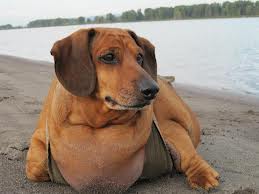According to The Association for Pet Obesity Prevention (APOP)http://www.petobesityprevention.com/, it is estimated that half of the pets in the US are obese!
Read about Obie, the 70-lb dachshund lumbering towards his new weight goal:
http://www.kptv.com/story/19589739/overweight-dachshund-on-a-mission-to-shed-pounds
And more about Obie:
http://www.kgw.com/news/Custody-battle-over-for-Obie-the-Dachshund-188245031.html
So, how do pets get this way? Well, it usually circles back to us. When I was putting together this blog, I couldn’t help but think back to some friends that had a lovely Golden Retriever. Not only did this dog get an excess of treats in addition to her regular feedings, but was served a nightly bowl of ice cream. This Golden was broad in the beam and was approaching seniorhood.
Pet Obesity Facts from dosomething.org:
1. According to the Association for Pet Obesity Prevention, 53 percent of adult dogs and 55 percent of cats in the U.S. are obese or overweight.
2. 22 percent of dog owners and 15 percent of cat owners said their pet’s weight was normal, when it was actually overweight or obese.
3. The “fat pet gap” is the normalization of obesity by pet parents. (Read: fat pets = the new normal.)
4. Dogs and cats who are 10 to 20 percent over their ideal body weight are considered overweight. Dogs and cats 20 percent over their ideal weight are considered obese.
5. A golden hamster should weigh 5 to 7 ounces and dwarf hamsters should weigh 3/4 to 1 3/4 ounces.
6. Obesity is the number one health problem in pet birds. Most birds have food available all the time, so they don’t have to work for their dinner. And because there’s not too much else to do, they sit around and rest all day.
7. Amazon parrots, cockatiels, rose-breasted cockatoos, canaries, quaker parrots and budgerigars are more prone to obesity than other birds.
8. Overweight or obesity can cause arthritis, diabetes, high blood pressure, kidney disease, certain cancers, heart and respiratory disease, and more for your pet.
9. According to the Purina Lifespan Study, obesity takes almost two years off a dog’s life.
10. To check if your pet is obese or overweight, you should be able to easily feel your pet’s ribs without pressing on the pet and your pet’s stomach should be tucked in.
11. Veterinarians determine if a pet is overweight or obese by their body condition score, or BCS. Veterinarians assess the amount of stored fat and assign a number to score if a pet is underweight, overweight, or just right.
Paradiseanimalhospital.com offers 7 Tips For Reducing Dog Obesity
Don’t use self-feeders, which can be describe as candy machines for fat dogs.
Pet your dog when he begs for food. Many dogs really want attention, so “flip the equation.”
Feed the dog small meals often. Divide the daily food servings into small portions.
If the dog is begging for food, take him for a walk as a distraction.
If the dog begs, just give him a few kibbles in his bowl, like 10 or 15 rather than a handful.
Dogs like a crunchy treat. So how about skipping anything fatty and switching to baby carrots, broccoli, celery, or asparagus?
Make sure the bowl is filled with water. Fresh water may hit the spot.
AND I WILL ADD A FEW MORE:
Walk, walk, walk your dog or hire a dog walker!!!
Play games with your dog/throw the ball or Frisbee.
30 minutes of exercise daily, commit to this!
HERE’S A COMPARISON CHART TO USE AS A GUIDE
Ten Steps To Help Your Cat Lose Weight from petloveshack.com
There may not be a fancy, brand-name diet program for fat cats yet, but there are other ways to help your cat drop those extra pounds. Follow these ten steps from Dr. Dan Carey, a veterinarian and director of technical communications at TheIams Company, to help your cat reach a healthier weight. First, always check with your veterinarian to establish goals and make sure your cat is otherwise healthy. Then, continue follow-up visits with your veterinarian to monitor progress.
Let the games begin! Help your cat burn calories by encouraging her to play. Toss her toys for her to chase, wiggle a wand for her to jump up high, or provide a taller cat scratching post for her to climb.
Go for a walk. Show those dogs a thing or two, and take your cat for a walk-even if it’s just inside the house. Many cats learn to enjoy walking on a leash, especially if trained while still young. It’s a great excuse for you to get more exercise, too.
Ease into shape. Watch how your fat cat handles increased activity. Don’t let your cat become exhausted, overheated or out of breath. Also remember that older cats may not be able to exercise vigorously.
Replace treats with praise. When your cat is begging for treats, it could be that she’s just begging for your attention. Substitute play, grooming, stroking or conversation for food treats as expressions of love. You can also try catnip as a non-food treat.
Resist those pleas. Is your cat an expert at begging for table scraps? If you find it difficult to ignore those “sad eyes” (or wailing!) at mealtime, keep your feline in a separate room.
Feed cats individually. If you have more than one cat, consider keeping them in separate rooms during their mealtime. This will prevent the greediest cat from overeating, and ensure that slower cats get fed.
Play fetch. Toss dry food kibbles to your cat, one piece at time, to combine exercise with mealtime.
Avoid fiber overload. Many reduced calorie pet foods include increased levels of fiber that can interfere with a pet’s ability to absorb and digest nutrients. Food with the proper balance of animal-based protein, fat, carbohydrates and moderately fermentable fiber sources, such as beet pulp, is a healthier choice. Try new Eukanuba® Weight control Formula for Cats-which also has a unique Feline Fat Burner systemª, which promotes health and well-being while helping cats to burn fat and lose or maintain weight successfully.
Smaller meals, more often. As with people, several smaller meals each day vs. one large serving help cats burn more calories. This is through meal-inducedthermogenesis-heat produced by the body during digestion, absorption, metabolism and storage of nutrients actually causes more calories to be used.
Tip the scales. A baby scale works great for keeping track of your cat’s weight, or alternatively you can take your cat in your arms, step on your own scale and then subtract your weight from the total weight shown to find your cat’s weight. Check weight loss progress every two weeks.












